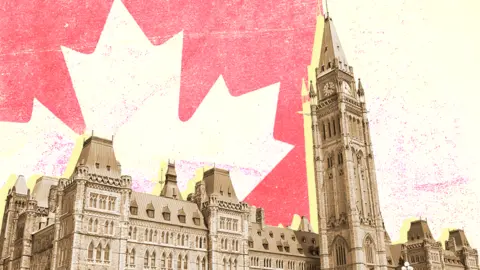A simple guide to Canada's federal election
 BBC
BBCMark Carney, former two-time central banker, was sworn in as Canada's new prime minister in mid-March after being elected leader of the Liberal Party of Canada.
Shortly after, he called a snap general election.
Several political leaders had called for a vote after former Prime Minister Justin Trudeau announced he was resigning as leader of the Liberals in January.
When US President Donald Trump imposed tariffs on the country, sparking a trade war, calls grew for Canada to go to the polls as soon as possible.
When is the next Canadian federal election?
The election is being held on Monday 28 April.
By law, the maximum time between federal elections in Canada is five years. The next vote was officially scheduled for 20 October 2025.
However, an early election was triggered when the Canada's governor general accepted the prime minister's advice to dissolve Parliament.
Politicians have been campaigning - and the party leaders criss-crossing the country - in the 36 days leading up to election day.
Who could be prime minister?
In the Canadian federal election - as in the UK's general election - voters do not cast a ballot directly for a prime minister.
Instead, the leader of the party with the majority of members of parliament (MPs) becomes PM.
That means Carney will be in the running, along with Pierre Poilievre, who leads the opposition Conservative Party, and Jagmeet Singh, the leader of the New Democratic Party.
Which parties will run candidates in the election?
Four main parties will contest the next election - the Liberals, the Conservatives, the New Democrats (NDP) and the Bloc Quebecois.
The Liberal Party has been in power since 2015, when Trudeau was voted in. At dissolution, it held 153 seats.
The Conservatives were the official opposition with 120 seats.
The Bloc Québécois, which only runs candidates in the province of Quebec, had 33 seats, and the NDP had 24.
The Green Party held two seats.
What do the polls say?
During the latter stages of Trudeau's premiership, opinion polls consistently showed the Conservatives with a strong lead.
After Trudeau stepped down at the start of 2025 - under intense pressure from his own party - the Liberals' fortunes began to improve.
Still, on 20 January - the day of Trump's inauguration - the Conservatives were polling at 44.8% while the Liberals were on 21.9%.
Following Trump's decision to introduce steep tariffs against Canada, however, the gap closed considerably.
By the eve of the election, the Liberals enjoyed a lead. An average of national polls suggest about 42.5% of Canadians back them, while 38.9% support the Conservatives.
This marks the first time in three years the Liberals are leading in the polls.
How to respond to President Trump's economic threats has become a dominant issue for voters, along with the cost of living, the economy and the housing affordability crisis.
How does the Canadian federal election work?
There are 343 federal ridings - also called constituencies or electoral districts -across the country. Each has a corresponding seat in the House of Commons.
All the seats in the lower chamber, the House of Commons, are up for grabs during an election.
Members of the Senate, the upper chamber, are appointed and do not run for election.
Like the UK, Canada has a "first-past-the-post" electoral system.
The candidate who gets the most votes in each riding wins that seat and become an MP. They do not need to get the majority of all the votes cast in their area. Other parties win nothing in that area.
The leader of the party with the largest number of elected MPs normally forms the government. The second-placed party usually forms the official opposition.
If no party ends up with an overall majority of seats, the result is known as a hung parliament or a minority government.
Practically, it means the party with the most seats will not be able to pass legislation without the help of other parties.
Who can vote in the Canadian federal election?
To vote in a Canadian election you must:
- be a Canadian citizen
- be at least 18 years old, and
- have proof of your identity and address
Canadians also had the chance to cast a ballot in advanced polls over the Easter weekend. A record 7.3 million did so.
